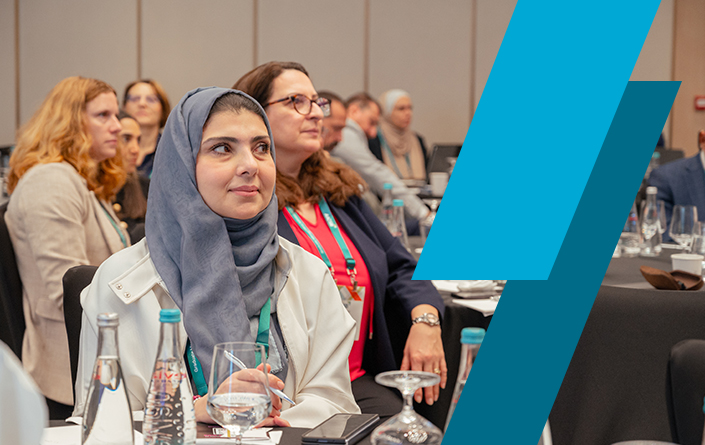The Transformative Force of Innovation
- By actively listening to community members and industry partners, business schools can hear new voices and ideas, which leads to new value creation.
- Grand challenges do not exist in isolation and therefore cannot be solved in isolation. Accordingly, business education should aim to be a platform for collaboration.
- Business schools should consider engaging in problem-seeking, in addition to problem-solving, to better understand emergent challenges in society.
Learn about AACSB's Innovations That Inspire program at aacsb.edu/innovations-that-inspire.
Transcript
Nancy Swanger: [0:15] Business schools have a great opportunity now to leverage some of the things they've been doing for a very long time and repackaging those into some new opportunities. What we first need to realize is that as business school faculty and administrators, we don't have to come up necessarily with all those new products or those new ideas or new solutions.
[0:40] If we take the time to talk to some of our stakeholders and particularly our industry partners, they have some great ideas. I've let the industry tell us what we need to do with the program. Learning to be a great listener and then taking some of those ideas and morphing them into our business schools, tremendous opportunities. We just need to get out of our own way.
Subbu Sivaramakrishnan: [1:03] Business schools or educational institutions, in general, have two major roles to play. One is creating knowledge, and the other is imparting the knowledge. The creating the knowledge is the research part of a business school, which is where we come up with innovative ideas, concepts, tools, strategies, tactics, and so on, for the business world to use.
[1:27] Then there's the dissemination part, which is the imparting knowledge, where we disseminate the innovations that are generated through research, not just at our business school, but any business school in general, to students which then reaches the business community. We should be doing this for the betterment of society in general.
The big issues that are faced by society today cannot be understood, let alone addressed, by any field of expertise or business discipline in isolation.
Mary Conway Dato-on: [1:48] If you want to be innovative and you want your students to be innovative, you have to put them where innovation is already happening. That's often in the classroom, but it's often outside of the classroom as well. When we think of a lack of borders between the university and the community, then we can think about innovation.
[2:10] At the Global Links Initiative, we embed that innovation in our values. We start with our first value of empathy. When we are empathetic, we understand the point of view, the different people who are involved in creating. Then that creates a community, and from that community, we in fact have dignity, diversity, respect. From that, comes innovation. Not the other way around.
Parag Patel: [2:34] In a contemporary world of business and society, things change at a breakneck speed. Without continuous innovations, business schools will not be able to deliver stakeholder value. Today, every grand challenge of the society is not unit discipline. Therefore, it needs to have a very interdisciplinary solution.
Christine Mathies: [3:04] The big issues that are faced by society today cannot be understood, let alone addressed, by any field of expertise or business discipline in isolation. Innovation is a really critical tool to help students and professionals to interrelate and connect the various domains of our expertise and to build the skills that are required to tackle the big challenges and tap into the opportunities for our society.
When we think of a lack of borders between the university and the community, then we can think about innovation.
Mohamad Sepehri: [3:27] We normally think of value for a student as goes through school, pays for it, then return on investment, but that's not really it. That's only one small part of it. The value creation is about the impact that our learning and our education will have on society at large, for the good of the people and for the good of the society, progress of the society. That's what the value is created.
[3:56] If we hear of people who are doing things with whatever they learned and moving the needle to the next level, we are proud that we have created that value. If I hear somebody just became a multimillionaire, that's not by itself really. It's good, but that's not the value we are looking for. What good do they do to the society a to everyone else?
Edita Gimžauskienė: [4:22] If you want to innovate, you have to be part of the ecosystem or develop the ecosystem. That's important because you open the discussion of the different stakeholders, you create the platform for cooperation and collaboration.
[4:38] The other thing, which is really important, if we want to have those technologies like ChatGPT and other things, which are really extremely now important and popular, if we want to serve for us and for the better world, we have to set a clear rules, ethics in some kind of principles.
[1:46] For business school, it's extremely important to change, to have the shift from development of the people who are working for shareholders' wellbeing to wellbeing for all.
If you want to innovate, you have to be part of the ecosystem or develop the ecosystem.
Ben Eng: [5:14] Business schools can leverage innovation to create value for learners, businesses, and society by doing two things. The first thing is problem-seeking, and the second thing is problem-solving. By problem-seeking, what I mean by that is how can we more deeply understand and not just understand, but empathize with the challenges that learners, businesses, and society have.
[5:38] For example, emergent challenges like how do learners cope with remote learning? How do our businesses cope with remote working? How does society deal with things like AI? Which leads to the second point is, how can we help use innovation to problem solve?
[6:00] With problem-solving, really want to focus on creating amazing, exciting innovations for those emergent problems that not just work, but that truly delight and transform for our stakeholders. If we can do those things, I believe that business schools can not only be an evolutionary force, but a transformative and revolutionary force for our learners, businesses, and society.






